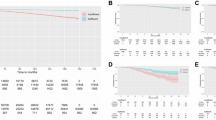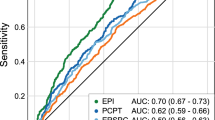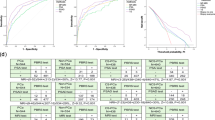Abstract
Background:
In an era of personalized medicine, individualized risk assessment using easily available tools on the internet and the literature are appealing. However, uninformed use by clinicians and the public raises potential problems. Herein, we assess the performance of published models to predict insignificant prostate cancer (PCa), using a multi-national low-risk population that may be considered for active surveillance (AS) based on contemporary practice.
Methods:
Data on men suitable for AS but undergoing upfront radical prostatectomy were pooled from three international academic institutions in Cambridge (UK), Toronto (Canada) and Melbourne (Australia). Four predictive models identified from literature review were assessed for their ability to predict the presence of four definitions of insignificant PCa. Evaluation was performed using area under the curve (AUC) of receiver operating characteristic curves and Brier scores for discrimination, calibration curves and decision curve analysis.
Results:
A cohort of 460 men meeting the inclusion criteria of all four nomograms was identified. The highest AUCs calculated for any of the four models ranged from 0.618 to 0.664, suggesting weak positive discrimination at best. Models had best discriminative ability for a definition of insignificant disease characterized by organ-confined Gleason score ⩽6 with a total volume ⩽0.5 ml or 1.3 ml. Calibration plots showed moderate range of predictive ability for the Kattan model though this model did not perform well at decision curve analysis.
Conclusions:
External assessment of models predicting insignificant PCa showed moderate performance at best. Uninformed interpretation may cause undue anxiety or false reassurance and they should be used with caution.
This is a preview of subscription content, access via your institution
Access options
Subscribe to this journal
Receive 4 print issues and online access
$259.00 per year
only $64.75 per issue
Buy this article
- Purchase on Springer Link
- Instant access to full article PDF
Prices may be subject to local taxes which are calculated during checkout



Similar content being viewed by others
References
Schröder FH, Hugosson J, Roobol MJ, Tammela TL, Ciatto S, Nelen V et al. Prostate-cancer mortality at 11 years of follow-up. N Engl J Med 2012; 366: 981–990.
Andriole GL, Crawford ED, Grubb RL 3rd, Buys SS, Chia D, Church TR et al. Prostate cancer screening in the randomized prostate, lung, colorectal, and ovarian cancer screening trial: mortality results after 13 years of follow-up. J Natl Cancer Inst 2012; 104: 125–132.
Epstein JI, Walsh P.C., Carmichael M, Brendler CB . Pathologic and clinical findings to predict tumor extent of nonpalpable (stage T1c) prostate cancer. Clev Clin J Med 1994; 271: 368.
Stamey TA, Freiha FS, McNeal JE, Redwine EA, Whittemore AS, Schmid HP . Localized prostate cancer. Relationship of tumor volume to clinical significance for treatment of prostate cancer. Cancer 1993; 71: 933.
Klotz L, Zhang L, Lam A, Nam R, Mamedov A, Loblaw A . Clinical results of long-term follow-up of a large, active surveillance cohort with localized prostate cancer. J Clin Oncol 2010; 28: 126–131.
Bangma C, Bul M, Zhu X, Valdagni R, Pickles T, Kakehi Y et al. Active surveillance for low-risk prostate cancer worldwide: The PRIAS Study. Eur Urol 2012; 63: 597–603.
Wong L-M, Alibhai SMH, Trottier G, Timilshina N, Van der Kwast T, Zlotta A et al. A negative confirmatory biopsy among men on active surveillance for prostate cancer does not protect them from histologic grade progression. Eur Urol 2013; 66: 406–413.
Tosoian JJ, Trock BJ, Landis P, Feng Z, Epstein JI, Partin AW et al. Active surveillance program for prostate cancer: an update of the Johns Hopkins experience. J Clin Oncol 2011; 29: 2185–2190.
Adamy A, Yee DS, Matsushita K, Maschino A, Cronin A, Vickers A et al. Role of prostate specific antigen and immediate confirmatory biopsy in predicting progression during active surveillance for low risk prostate cancer. J Urol 2011; 185: 477–482.
Hardie C, Parker C, Norman A, Eeles R, Horwich A, Huddart R et al. Early outcomes of active surveillance for localized prostate cancer. BJU Int 2005; 95: 956–960.
Wong L-M, Johnston R, Sharma N, Shah N, Warren A, Neal DE . General application of the National Institute for Health and Clinical Excellence (NICE) guidance for active surveillance for men with prostate cancer is not appropriate in unscreened populations. BJU Int 2012; 110: 24–27.
Wong L-M, Neal DE, Johnston RB, Shah N, Sharma N, Warren AY et al. International multicentre study examining selection criteria for active surveillance in men undergoing radical prostatectomy. Br J Cancer 2012; 107: 1467–1473.
Steyerberg EW, Roobol MJ, Kattan TH, van der Kwast TH, Koning HJ, Schröder FH . Prediction of indolent prostate cancer: validation and updating of a prognostic nomogram. J Urol 2007; 177: 107–112.
Nakanishi H, Wang X, Ochiai A, Trpkov K, Yilmaz A, Donnelly JB et al. A nomogram for predicting low-volume/low-grade prostate cancer. A tool for selecting patients for active surveillance. Cancer 2007; 110: 2441–2447.
O’Brien BA, Cohen RJ, Ryan A, Sengupta S, Mills J . A new preoperative nomogram to predict minimal prostate cancer: accuracy and error rates compared to other tools to select patients for active surveillance. J Urol 2011; 186: 1811–1817.
Kattan MW, Eastham JA, Wheeler TM, Maru N, Scardino PT, Erbersdobler A et al. Counseling men with prostate cancer: a nomogram for predicting the presence of small, moderately differentiated, confined tumors. J Urol 2003; 170: 1792–1797.
Chun FK, Haese A, Ahyai SA, Walz J, Suardi N, Capitanio U et al. Critical assessment of tools to predict clinically insignificant prostate cancer at radical prostatectomy in contemporary men. Cancer 2008; 113: 701.
Wolters T, Roobol MJ, van Leeuwen PJ, van den Bergh RCN, Hoedemaeker RF, Van Leenders GJLH et al. A critical analysis of the tumor volume threshold for clinically insignificant prostate cancer using a data set of a randomized screening trial. J Urol 2011; 185: 121–125.
Cooperberg MR, Cowan JE, Hilton JF, Reese AC, Zaid HB, Porten SP et al. Outcomes of active surveillance for men with intermediate-risk prostate cancer. J Clin Oncol 2011; 29: 228–234.
Memorial Sloan-Kettering Cancer Center. Prostate Cancer. Prediction Tools. mskcc.org. 2013 (cited 2014 May 5). Available from http://www.mskcc.org/cancer-care/adult/prostate/prediction-tools.
SWOP – The Prostate Cancer Research Foundation, Rotterdam. Calculate your prostate cancer risk - Risk Calculator 5. Roobol M, editor. prostatecancer-riskcalculator.com. Rotterdam; 2013 (cited 2014 May 5). Available from http://www.prostatecancer-riskcalculator.com/.
Vickers AJ, Cronin AM . Everything you always wanted to know about evaluating prediction models (but were too afraid to ask). Urology 2010; 76: 1298–1301.
Hanley JA, McNeil BJ . The meaning and use of the area under a receiver operating characteristic (ROC) curve. Radiology 1982; 143: 29–36.
Vickers A, Elkin EB . Decision curve analysis: a novel method for evaluating prediction models. Med Decis Making 2006; 26: 565–574.
Corcoran NM, Hong MK, Casey RG, Hurtado-Coll A, Peters J, Harewood L et al. Upgrade in Gleason score between prostate biopsies and pathology following radical prostatectomy significantly impacts upon the risk of biochemical recurrence. BJU Int 2011; 108: E202–E210.
Iremashvili V, Soloway MS, Pelaez LT, Rosenberg DL, Manoharan M . Comparative validation of nomograms predicting clinically insignificant prostate cancer. Urology 2013; 81: 1202–1208.
Eichler K, Hempel S, Wilby J, Myers L, Bachmann LM, Kleijnen J . Diagnostic value of systematic biopsy methods in the investigation of prostate cancer: a systematic review. J Urol 2006; 175: 1605–1612.
Epstein JI, Allsbrook WCJ, Amin MB, Egevad LL, ISUP Grading Committee. The 2005 International Society of Urological Pathology (ISUP) consensus conference on Gleason grading of prostatic carcinoma. Am J Surg Pathol 2005; 29: 1228–1242.
Wang S-Y, Cowan JE, Cary KC, Chan JM, Carroll PR, Cooperberg MR . Limited ability of existing nomograms to predict outcomes in men undergoing active surveillance for prostate cancer. BJU Int 2014; 114: E18–E24.
Vargas HA, Akin O, Franiel T, Mazaheri Y, Zheng J, Moskowitz C et al. Diffusion-weighted endorectal MR imaging at 3 T for prostate cancer: tumor detection and assessment of aggressiveness. Radiology, 2011 ed. 2011; 259: 775–784.
Scattoni V, Lazzeri M, Lughezzani G, De Luca S, Passera R, Bollito E et al. Head-to-head comparison of prostate health index and urinary PCA3 for predicting cancer at initial or repeat biopsy. J Urol 2013; 190: 496–501.
Cooperberg M, Simko J, Falzarano S, Maddala T, Chan J, Cowan J et al. Development and validation of the biopsy-based genomic prostate score (GPS) as a predictor of high grade or extracapsular prostate cancer to improve patient selection for active surveillance. J Urol 2013; 189: e873.
Acknowledgements
Princess Margaret Hospital Prostate Centre database was conceived and maintained by the very generous financial and support of the Weinbaum Family Foundation with administrative support by the Princess Margaret Cancer Centre Foundation. We acknowledge the support of The University of Cambridge, Cancer Research UK and Hutchison Whampoa Limited. We acknowledge the support of the National Institute for Health Research, which funds the Cambridge Biomedical Research Centre, Cambridge, UK. We also acknowledge the support of the National Cancer Research Prostate Cancer: Mechanisms of Progression and Treatment (PROMPT) collaborative (grant code G0500966/75466), which has funded tissue and urine collections in Cambridge. We also acknowledge the support of the Cambridge Cancer Research Foundation. The Human Research Tissue Bank is supported by the NIHR Cambridge Biomedical Research Centre.
Author information
Authors and Affiliations
Corresponding author
Ethics declarations
Competing interests
The authors declare no conflict of interest.
Rights and permissions
About this article
Cite this article
Wong, LM., Neal, D., Finelli, A. et al. Evaluation of models predicting insignificant prostate cancer to select men for active surveillance of prostate cancer. Prostate Cancer Prostatic Dis 18, 137–143 (2015). https://doi.org/10.1038/pcan.2015.1
Received:
Revised:
Accepted:
Published:
Issue Date:
DOI: https://doi.org/10.1038/pcan.2015.1
This article is cited by
-
Live-cell phenotypic-biomarker microfluidic assay for the risk stratification of cancer patients via machine learning
Nature Biomedical Engineering (2018)
-
Aktive Überwachung beim Niedrig-Risiko-Prostatakarzinom
Der Urologe (2016)
-
Performance of biopsy factors in predicting unfavorable disease in patients eligible for active surveillance according to the PRIAS criteria
Prostate Cancer and Prostatic Diseases (2015)



